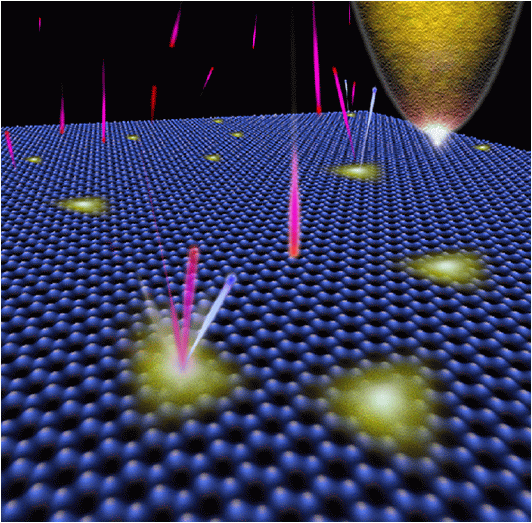Point defects in graphene systems
We investigate, at the atomic scale, the impact that point defects have in the structural, electronic and magnetic properties of graphene layers grown on different materials.
Such defects are expected to have a dramatic impact in graphene properties due to it’s pure bidimensionality

HOPG

By selectively removing individual carbon atoms from the graphite surface, we showed that vacancies lead to a dramatic reduction of the electronic mobility and confirmed the creation of magnetic moments associated to the vacancies in this pure carbon material, indicating a suitable route to the creation of non-metallic, cheaper, lighter, and bio-compatible magnets.
Physical Review Letters 104, 096804 (2010) Article ![]()
G/Pt(111)

Our findings demonstrate that even in weakly coupled graphene/metal systems the presence of the metal has to be seriously taken into account in order to controllably tune graphene properties by locally modifying its structure. In particular, we have demonstrated that the interaction with the metal strongly increases when single C vacancies are introduced in the graphene layer, discarding the appealing possibility of inducing magnetic properties on this graphene system by removing C atoms.
Physical Review Letters 107 116803 (2011) Article
Divacancy

We showed that carbon divacancies can be artificially introduced by ion irradiation in several graphene systems. Our results reveal that such divacancies accommodate two adjacent missing atoms in a planar structure formed by two pentagons and one octagon (585 defect) with no dangling bonds, being thus much less reactive than other vacancy-type defects. We demonstrated that divacancies are expected to limit the electron mobility and, unlike the case of monovacancies, they are a non-magnetic defect.
Physical Review B 85, 121402 (R) (2012) Article ![]()
![]()
Superconducting nanoparticles

Sn Nanoparticles.
We have shown how the superconducting energy gap can be enhanced by ~60% from its bulk value in superconducting nanoparticles of Sn which are at the limit of superconductivity for a zero dimensional system. Though the occurrence of these ‘shell effects’ which originates from quantum confinement had been predicted theoretically, our experiments on single, isolated Sn nanoparticles by a scanning tunneling microscope show for the first time in a real system that the superconducting energy gap is very sensitive on the particle size and shape and very small changes can cause large oscillations in its value, leading to huge enhancements.
Nature Materials 9, 550 (2010) Article highlighted in ![]()
Pb Nanoparticles.
We reported direct experimental evidence of thermal fluctuations and the gradual breakdown of superconductivity in Pb nanoparticles as the size is reduced. The experimental data was well described by a theoretical model. Thermal fluctuations give rise to a finite energy gap or “fluctuation dominated regime” around Tc. Our results are a first step to understand quantitatively the evolution of superconductivity with particle size and the role of thermal fluctuations for single small superconductors.
Phys. Rev. B. 84, 104525 (2011) Article ![]()
